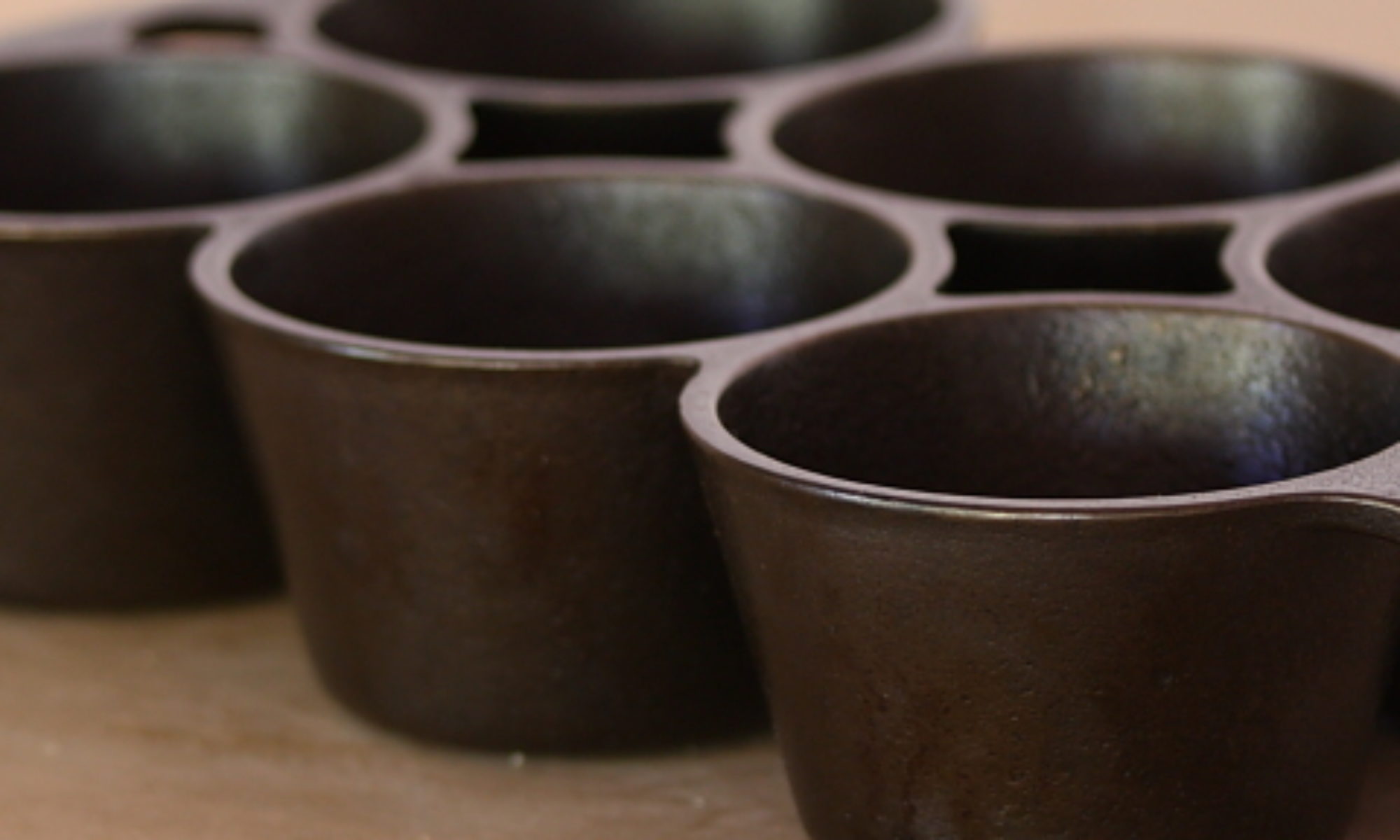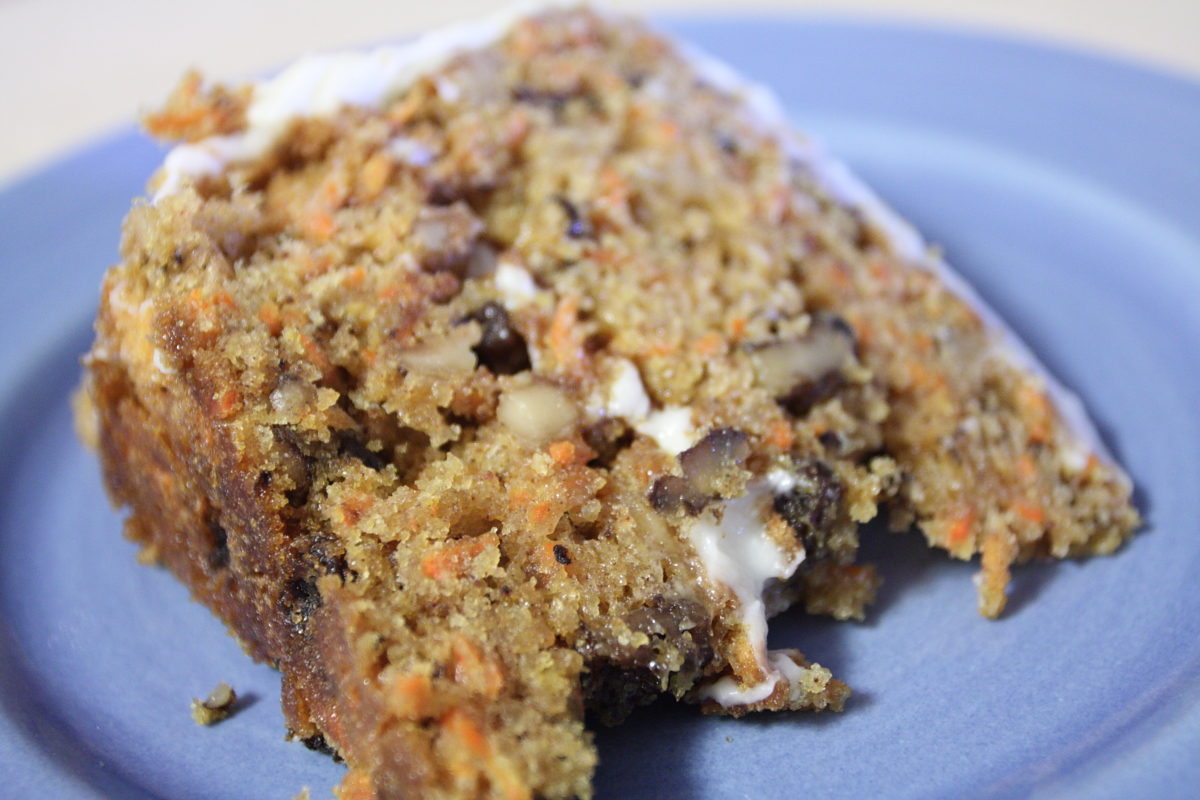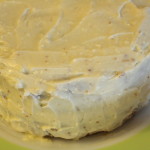
Over the past couple of weeks, we’ve been getting huge carrots in our CSA shares. Each carrot is often over a half pound! That’s one big carrot. You’d think that they’re woody, tough, and kind of flavorless, but, instead, even at this size, they’re sweet and tender. But, we still have the question of what do you do with lots of huge carrots? For a weekend treat, we went with carrot cake.
It’s funny that we’ve never made a carrot cake before, as it’s one of our favorite cakes, mainly because the cake part isn’t very sweet. The frosting, however, is often too sweet for our tastes. Since we hadn’t made carrot cake, we were just going to break out our standard The Joy of Cooking and try their recipe, but we happened to have The New Best Recipe from the Editors of Cook’s Illustrated checked out of the library. In looking at all the testing they went through to get the ultimate carrot cake (amount of carrots, do you want butter or oil, how much of each, how much flour, how much baking powder and baking soda for lift, and on, and on, for nearly two pages), we thought we had to try this version.
Don’t let the length of these instructions scare you off. This is a great, fool-proof, and pretty easy cake to make from scratch. It seems like a lot of steps, but really it’s shred carrots, mix some dry ingredients, mix liquid ingredients, then mix liquid and dry ingredients together, and bake. That’s it, in a nutshell.
Makes two 8-inch rounds or one 9×13-inch cake.
Carrot Cake with Cream Cheese Frosting
Ingredients
For the cake
- 2 1/2 cups all-purpose flour
- 1 1/4 tsp baking powder
- 1 tsp baking soda
- 1 1/4 tsp cinnamon
- 1/2 tsp freshly grated nutmeg
- 1/8 tsp ground cloves
- 1/2 tsp salt
- 1 pound carrots peeled
- 1 1/2 cups granulated sugar
- 1/2 cup packed light brown sugar
- 4 large eggs
- 1 1/2 cups safflower canola, or vegetable oil
- 1 1/4 cups walnuts toasted
- 1 cup raisins
For the frosting
- 8 ounces cream cheese softened
- 5 Tbs unsalted butter softened
- 1 Tbs sour cream
- 1 tsp vanilla extract
- 1 1/4 cups confectioners' sugar
Instructions
For the cake
- Spray two 8-inch cake pans with cooking spray, line with parchment, then spray the parchment.
- Preheat oven to 350°F. Adjust rack to center of oven.
- In a medium bowl, whisk together flour, salt, spices, baking powder and baking soda.
- Using the grating blade of a food processor, grate carrots. Add carrots, nuts, and raisins to flour mixture and set aside. Wipe out food processor bowl.
- With the metal chopping blade in place, place sugars and eggs in the food processor bowl. Process until frothy and completely combined, about 20 seconds.
- While the processor is running, pour in the oil, and process until well blended, about 20 seconds.
- Scrape batter from processor into a large bowl. Add flour/carrot mixture and stir until combined.
- Divide batter between the two cake pans, and bake for 45 to 50 minutes, rotating halfway through baking, or until a toothpick inserted in the center comes out clean.
- Remove to rack and let cool for at least 2 hours, then run a knife around the edge and turn out cakes.
For frosting
- In a medium bowl, combine frosting ingredients. Mix until well blended.
To assemble
- Place one cake on a plate, spread a thin layer of frosting over it, then place second cake inverted on top. Frost entire cake with a thin layer of frosting.
Ingredient discussion:
When we made this cake, we actually went by weight for the flour (12 1/2 ounces), granulated sugar (10 1/2 ounces), and brown sugar (3 1/2 ounces). For some things, it’s actually easier than scooping, etc. You know our stance on eggs, so don’t ask. For the vanilla extract, never buy imitation. Sure, it’s cheaper, but it’s not as good. And, finally, the amount of frosting that this recipe makes is just enough for a thin layer on the cake; if you like thicker frosting, make a double batch.
Update: Before you make this frosting, you can find (after May 25) a better version here.
Procedure in detail:
For the cake.
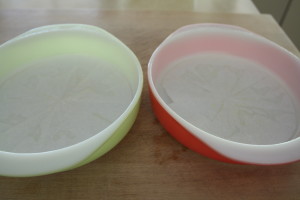
Prepare pans. As suggested in the original recipe, we went with the cooking spray and sprayed our two pans, then placed the parchment paper on the bottom, and sprayed again. If you don’t have cooking spray, shortening or butter will work, too. Carrot cakes were made long before cooking spray.
Preheat oven to 350°F.
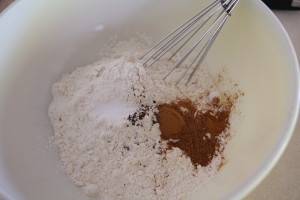
Whisk flour. In a medium bowl, whisk together the flour, salt, spices, baking powder, and baking soda. We didn’t have any ground cloves, so we got out three whole cloves and crushed them with the back of a spoon on a cutting board. We also didn’t have freshly-grated nutmeg, so in went in ground nutmeg. Once we had that, we whisked until the flour mixture was an even color.
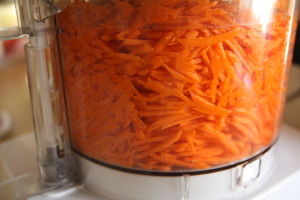
Shred carrots. We used our food processor for grating the carrots. It’s super fast and it makes nice, cleanly-cut shreds. If we were only grating the carrots, we wouldn’t bother with the food processor because of the clean- up. In this case, we’ll be making part of the batter in it later, so it’s not so bad.
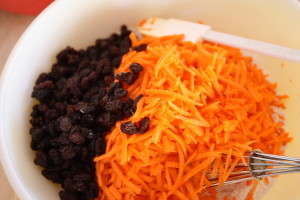
Add carrots. Add the carrots and raisins to the flour mixture and stir to coat. We did that mainly so the carrots wouldn’t discolor while they were sitting there. No, it won’t make a difference in the taste or color of the final cake; it just would be odd to look at carrots browning when we don’t have to.
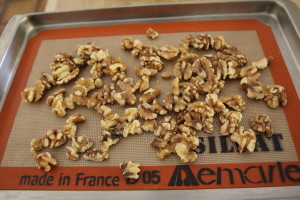
Toast and chop nuts. Spread the walnuts on a baking tray, and bake in the hot oven for 10 minutes, or until toasted a light brown. Check on them regularly during the last few minutes of baking to make sure they are not burning. Once done, chop into 1/4-inch pieces, add to the flour/carrot mixture, and mix to coat.
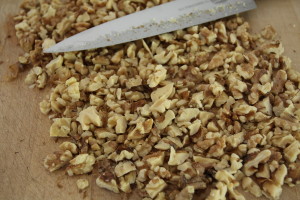
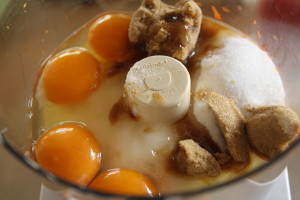
Mix eggs and sugar. Here’s one place where a scale comes in handy. It’s always troublesome to pack brown sugar into a cup for measuring. If you don’t use brown sugar often, it becomes hard (we keep ours in the freezer, but big chunks still come off) and clumpy. Instead, place the processor bowl on a scale, tare it, and start adding brown sugar until you have 3 1/2 ounces. No packing required. Add the granulated sugar, and crack the eggs on top. Process until well mixed; about 5 pulses, and 20 seconds, worked for us.
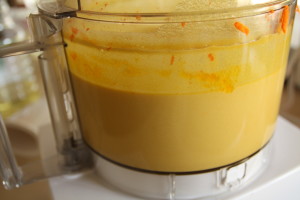
Add oil. Let the processor continue to run and start pouring in the oil. It’s not as if we were making mayonnaise, so we just poured it in a steady stream, about 10 second for a cup. Let the processor run until the batter is light yellow and looks creamy smooth; about 20 seconds should do it.
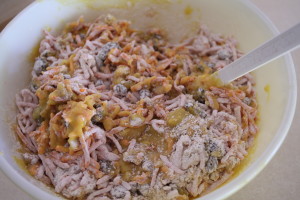
Complete batter. Scrape the egg/sugar/oil batter into a large bowl — we used a 4-quart bowl, since anything smaller might have been trouble. Stir in the flour/carrot/nut mixture. Stir just long enough to make a batter without dry flour spots.
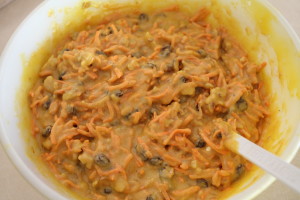
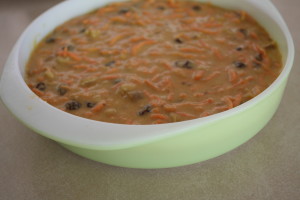
Divide and bake. We poured and scraped the batter into our two prepared pans and leveled off the top. Then, into the oven for 45 to 50 minutes. Since each oven has its own particularities, we made sure to rotate the pans halfway through the baking time. To test for doneness, insert a toothpick into the center; if it comes out clean, you cake is baked.
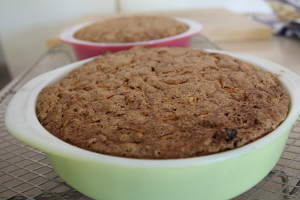
Cool. Set the cake pans on a rack and let cool until room temperature, about 2 hours, before trying to remove from the pans. You went to a bit of trouble to make the cakes, so you don’t want to ruin them by taking them out too early and having them fall apart, do you? We distracted ourselves by making dinner while they cooled.
For the frosting.
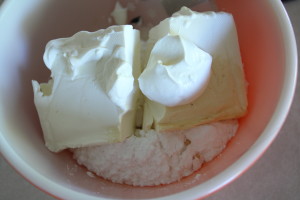 Make frosting. In a small bowl, or even a mixer, blend together frosting ingredients. We did have a bit of trouble getting the cream cheese to blend in using just a rubber spatula, and, in retrospect, we’d use a mixer to make a smoother frosting, but it tastes the same. In reality, next time we make this frosting, we’re going to whip up a small amount of cream and fold that in for a lighter, less sweet, frosting. When we do, we’ll let you know how that turns out. (After May 25 see this post.)
Make frosting. In a small bowl, or even a mixer, blend together frosting ingredients. We did have a bit of trouble getting the cream cheese to blend in using just a rubber spatula, and, in retrospect, we’d use a mixer to make a smoother frosting, but it tastes the same. In reality, next time we make this frosting, we’re going to whip up a small amount of cream and fold that in for a lighter, less sweet, frosting. When we do, we’ll let you know how that turns out. (After May 25 see this post.)
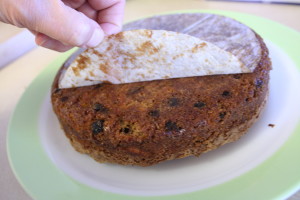
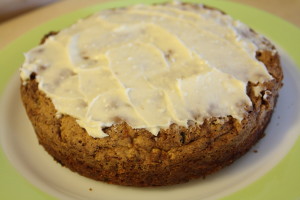
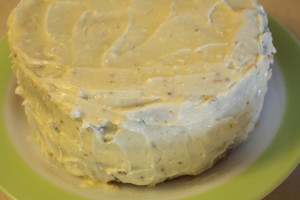
Assemble cake. Run a blunt knife around the edge of the pan, and invert the cake unto your hand. Remove parchment, and transfer to a plate, right side up. Spread a small amount of frosting on top. Remove the second cake and place on top of the first upside down, so you’ll have a smooth top to frost. Remove parchment. Frost as best you can. We really need practice frosting cakes, so, while we got the top looking pretty good, we really only coated about half of the sides, maybe a bit more (we ran out of frosting). Fortunately, we were making it for ourselves, so it wasn’t a disaster.
First off, this is a great carrot cake. The cake itself deserves a full five stars. It’s moist, with just enough spice to keep it interesting, and, unlike some carrot cakes, it’s not too heavy. We must say that the research done by the editors of Cook’s Illustrated paid off in this case. But, we also must say that all their research and analysis would’ve been shortened if they’d just looked in The Joy of Cooking first. The recipe found there is almost identical, other than it’s cut in half to make a single cake. Ah, the more things change….
Now for the frosting. It was good but overly sweet, and, as we said above, next time we’re going to try to lighten it by folding in whipped cream at the end. Sure, it may be a bit more trouble, but, for a special occasion, we think that it’ll be worth it.
Update: We did significantly improve the frosting. You can find that (after May 25) here.
